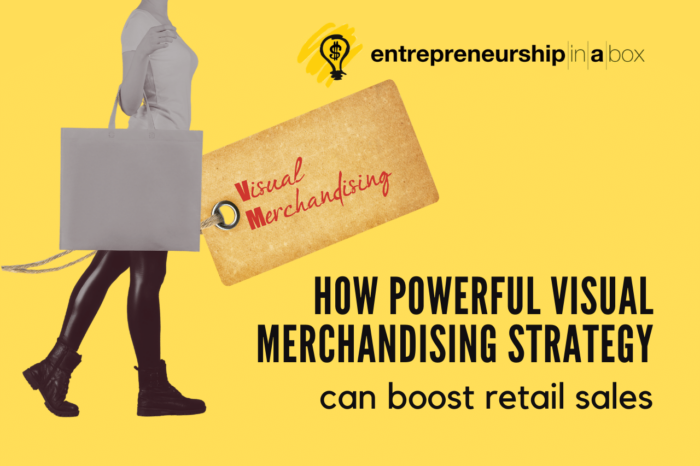It seems that a week no longer goes by without yet another news story about a major retail chain struggling to make ends meet. Retail stores can maximize their sales revenue with a few strategies, with visual merchandising.
Unsure what we mean by visual merchandising or struggling to apply the strategy effectively across your shops? We’ve put together this guide that advises on designing and introducing visual merchandising in a manner that should see your company’s profit margin receive a boost…
Why you shouldn’t ignore visual merchandising
Look into a visual merchandising strategy, and you’ll be getting to work designing an entire shop floor layout strategically. This includes the shelves and product displays to provide a more engaging, exciting, and ultimately profitable consumer experience.
However, visual merchandising means much more than simply setting up products in certain places around your stores so that they catch the eye. There’s a science behind why certain presentations, structures, and even colors deliver a better experience than alternative arrangements. A strong visual display can raise turnover and strengthen your brand, even inspiring customer loyalty in the process.
“Visual merchandising is everything a shopper sees at your store that hopefully leads to a remarkable shopping experience. It is the unspoken language retailers use to communicate with their customers,” explains Bob Phibbs, a chief executive officer who runs the retail consultancy firm The Retail Doctor in New York.
This covers what is meant by visual merchandising. Keep reading through to discover how to go about creating an effective strategy. So, you can avoid the difficulties that have been witnessed by brands such as Toys R Us and Maplin…
Related: Protecting Your Retail Store from Shoplifting: 4 Things to Know
Focus on what consumer want instead of what they need
By the time we reach 2020, global retail sales are expected to have reached USD 27.73 trillion. As a result, there’s clearly scope for your brand to maximize its profits and get a share of this growth in the next few years.
Think about the products you have in stock that you want to use to capture consumers’ attention when getting to work on a visual merchandising strategy. A tip here is to go for what you think your customer wants — not needs. According to a study by Raj Raghunathan and Szu-Chi Huang, emotional responses are influential in our purchasing choices — which is why you should focus on giving the customer something to desire.
For any focal visual merchandising displays at your stores, reserve these for only your newest and most high-end products. This is because they will attract the customer who is looking for a treat purchase. So, you can enhance your chances of high-cost conversions. You could also use outdoor signs alongside these displays to present promotional offers. Offers for luxury items that you want the consumer to take notice of — and buy!
Make the most of ‘decompression zones’ at your stores
If you’re aiming to give consumers an idyllic shopping experience from the moment they set foot in your store, look at the shop’s decompression zone. This area of a shop is found just a few feet inside the main entrance. It is believed by psychologists to elevate a shopper’s mood, acclimatize them to the store’s surroundings and get them ready for the shopping experience.
The experience needs to be the focus here. After all, who wants to browse and shop when they’re feeling negative or distracted? An effective decompression zone will help transport your consumer from the hustle and bustle of the outside to a calmer, more focused environment that encourages browsing. Here are decompression zone tips:
- Minimum of 10-15 feet.
- Based at shop entry with a full view of the store.
- Created using contrasting furnishings and colors from the outside area to signal a new atmosphere.
- Use mannequins, attractive stands, and specialized lighting to highlight your newest ranges.
According to research, 98% of consumers will turn right when they enter a shop. Why not use your decompression zone to create a circulation route. But from the right side leading around your store for a smoother customer journey? Or, try placing your best products at the right of your decompression zone if this is the most likely route consumers take.
Making effective use of group displays
Visual merchandising can often be a success or a failure based on the group products at your shop. A recent report found that exposing your shopper to the maximum number of products is a tactical method for visual merchandising. However, don’t make your displays look crowded. Utilize different display furniture, such as mannequins, racks, and shelves — whichever suits the product you’re merchandising. Bear in mind that focal points boost sales by a reported 229%. So ensure that you effectively direct your consumers when they enter your store.
The ‘Pyramid Principle’ or ‘Rule of Three’ methods are proven useful when placing various products into a display. The Pyramid Principle requires creating a triangular display, with the biggest item in the middle and the smallest on the outside. This will ensure that your display doesn’t look flat and boring. Instead, it will catch the eye, as the products seem to ‘fall’ down towards the viewer. Equally effective is the Rule of Three. Within this, you create the attractive asymmetry that shoppers will find engaging. Apparently, humans see asymmetry as normal — which means they pay less attention. By placing the product in three groups, you can create a noticeable imbalance. This imbalance forces the eye to take in each product individually instead of the display in its entirety. This is excellent for effectively advertising each item.
Add some color on your visual merchandising
“Things that are easy to look at will be passed over, and things that are too outlandish will be offensive to the eye,” points out retail merchandiser and stylist Jessica Clark. This goes for color as much as anything. Contrasting colors on the opposite side of the color wheel can help grab attention. Think black and white or scarlet and jade — but creating a multi-colored display of uncoordinated colors may turn people away.
Bear in mind all five human senses
Visuals have been the focus of this guide so far. However, don’t ignore the other four human senses. Reportedly, 75% of emotions come from the smell, and our mood is meant to enhance 40% when we detect pleasant aromas. If you run a fragrance, soap, or food retail establishment, are you harnessing the power of smell when it comes to merchandising?
Memories or emotions can be triggered or identified through different types of smell. If you run a bakery and want to evoke a feeling of warmth, coziness, and home-cooking, ensure that your customers can distinctly smell your products baking from the kitchen by setting up the area to waft aromas into the main shop. Similarly, if your brand specializes in soaps and toiletries, place them strategically around your shop floor to avoid clashing aroma. For example, put all the citrus products together. In such a way you will evoke a sense of energy and rejuvenation and keep these far away from lavender and chamomile scents, which are more relaxing.
Switch up visual merchandising displays regularly
Customers will feel great when you’ve completed a shop floor’s entire design. They will be satisfied with how things look and are arranged. However, this doesn’t mean you should let it stay that way. A major part of tactical visual merchandising is moving your presentations as new stock comes in. Don’t let customers get bored of visiting you. Keep changing things up. So, you can make it look like you’re constantly replenishing your stock and bringing in new and wonderful items. This will look in such a way even if you’re not bringing new items.
Promotions will only last for a limited period of time, while seasonal goods will only prove appealing to consumers for a few weeks at a time. Don’t give people the impression that your brand is behind the times or lazy. Instead, change your visual merchandising displays every month and retain the perception of innovation.
In the months and years ahead, the way we shop is expected to change quite drastically. If predictions are anything to go by, ‘the experience’ will become more favored than just buying goods and services. With visual merchandising, you can ensure that your shop offers something engaging to keep consumers interested. So why not start planning out your shop’s next visual merchandising campaign today?
Sources:





